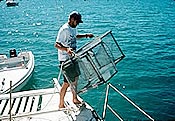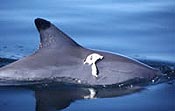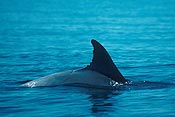
Research Projects – Indo-Pacific Bottlenose Dolphins

Indo-Pacific Bottlenose Dolphins

Many people think that dolphins are able to live their lives free of constraints and worries that most animals must face. In reality, this is not the case. Dolphins are almost constantly on the lookout for their next meal, which usually is made up of relatively small fish. Dolphins also have to stay safe from predators. Tiger sharks are the major threat to dolphins in Shark Bay, especially their calves. Despite the apparent importance of food availability and predation risk, there were no studies that systematically addressed how dolphins deal with the demands of getting a meal and not becoming one themselves until SBERP conducted just such a study from 1997-1999.
To understand how dolphins balance the demands of getting a meal with staying safe from sharks, we studied not just the dolphins, but also their fish prey and tiger sharks. Based on studies of other animals and behavioral ecological theory, we predicted that when tiger sharks were not in the bay, dolphins would be distributed between deep and shallow habitats directly proportional to the amount of prey in those habitats. However, when sharks moved in, dolphins should spend more time in safe areas no matter how much food there was in those areas!
Measuring Dolphin Predators and Prey

In Shark Bay, the best way to figure out which habitats have the most food is to set out fish traps. We set out traps more than 1000 times in all the habitats of the study area and in all seasons. Traps were baited with cut pilchards (a small fish) and allowed to soak for two hours before we retreived the traps and identified, measured, and weighed the fish in them. During the study, we sampled more than 15,000 fishes and found that there is more food for the dolphins in the shallow habitats than in the deep ones and that the amount of fish in shallow and deep habitats didn't change seasonally.

To understand how sharks influence dolphins, we had to determine when sharks were around and what habitats they preferred to spend their time in (see Tiger shark research for more information). Tiger sharks in the study area prefer to spend their time over shallow seagrass beds - especially along the edges. There is, however, a lot of variation in the abundance of tiger sharks. Tiger sharks are common in the summers but during the winter they often are not in the study are at all. Luckily for our studies, in some years sharks remained in the area during the winter, which lets us conduct a "natural experiment" to determine how sharks influence dolphin habitat use.
Studying Dolphins

To find out how tiger sharks might influence dolphin behavior, we measured habitat use patterns of dolphins by driving along ten set lines in both deep and shallow habitats (we made about 800 passes during our dolphin studies from 1997-1999). Whenever we saw dolphins, we would record their position, determine the number of dolphins in the group and their behavior (foraging, socializing, resting, traveling). We then would take pictures of their dorsal fins, which we can use to determine which individuals were present (each dolphin has a unique set of nicks and cuts out of the trailing edge of their dorsal fin). When dolphins rode on the bow wave created by our boat and the waters were calm we could check their bodies to see if there were any wounds or scars from tiger shark bites.
Dolphin Run-ins with Tiger Sharks


While tiger sharks may not kill many dolphins - we rarely find dolphin remains inside tiger sharks - they attack a very large proportion of the population. More than 74% of the dolphins in Shark Bay have at least one scar from a run-in with tiger sharks and many have multiple bites. One dolphin was attacked at least six times! We also estimated, based on the presence of fresh wounds, that at least 10% of the dolphins are attacked unsuccessfully every year. That means that every dolphin can expect to have a run-in with a shark sometime during their life and they should be wary of tiger sharks, especially sharks over 3m (10') long.
Just because a predator doesn't kill a particular species of prey very often (like tiger sharks and dolphins), doesn't mean that the prey won't change its behavior in order to be safe! Sometimes prey species are rarely found inside predators because they are so good at avoiding becoming a meal. This seems to be the case for dolphins.
Dolphin Habitat Use and Behavior in Response to Prey Availability and Tiger Shark Predation Risk

allow us to identify the dolphin.

in the study area, dolphins commonly
forage over the fish-rich shallows.

fish is so big the dolphin will have to
rub it on the bottom to break off
chunks it can swallow whole (dolphins
can't chew)!
We found that dolphins have to make trade-offs between getting an easy meal and staying safe from tiger sharks . . . at least during some times of the year! There is more fish for the dolphins in shallow seagrass beds than deeper waters no matter what time of year it is. When tiger sharks are not found in the study area, dolphins do exactly what we expect - most of them are found foraging in the fish-rich shallow waters. However, during the Australian summer (and some winters) tiger sharks are in the bay and they are most common in the shallow waters. What do the dolphins do? Most of them choose safety over an easier meal and switch to foraging in deep waters. Of course there are exceptions - juvenile males seem to take more risks than other dolphins and keep foraging in the shallows when tiger sharks are around. They payoff of getting a lot of energy must outweigh the risk of being attacked!
The dolphins that do stay in the shallows to forage when tiger sharks are around change the way they use the banks. Instead of feeding both in the middle and at the edges of the banks, as they do when sharks are absent, they feed almost exclusively near the edges of the banks. This tactic gives them easy access to deep waters where they can more easily escape tiger sharks (it would be harder for a dolphin encountering a shark in the middle of a bank - click here for more on escape tactic-dependent habitat shifts).
Maybe our most important finding is that the decisions that dolphins make are influenced by other species in the bay. Large tiger sharks are attracted to the area and the shallow seagrass banks not by dolphins, but by their main prey - dugongs. This means that decisions made by dugongs influence the dolphins because they share tiger sharks as a predator. This shows how strongly interconnected the Shark Bay ecosystem is and tells us that changes that we make to one part of a marine system may have dire, and unintended consequences for other parts of the ecosystem. See our indirect effects page for more information.
Recent studies using sable isotopes show that bottlenose dolphins feed on different species than tiger sharks and other, smaller, sharks in Shark Bay. It appears that many dolphins do not get a lot of their energy from seagrass-based food webs.
Dolphin Studies Publications
- Heithaus, M. R., J. J. Vaudo, S. Kreicker, C. A. Layman, M. Krutzen, D. A. Burkholder, K. Gastrich, C. Bessey, R. Sarabia, K. Cameron, A. Wirsing, J. A. Thomson, and M. M. Dunphy-Daly. 2013. Apparent resource partitioning and trophic structure of large-bodied marine predators in a relatively pristine seagrass ecosystem. Marine Ecology Progress Series in press
- Heithaus, M. R. and L. M. Dill. 2006. Does tiger shark predation risk influence foraging habitat use by bottlenose dolphins at multiple spatial scales? Oikos 114: 257-264.
- Dill, LM, Dill, ES, and Charles, D. 2003. Feeding preferences of the Monkey Mia dolphins: results from a simultaneous choice protocol. Marine Mammal Science 19: 650-660.
- Dill, L. M., M. R. Heithaus, and C. J. Walters. 2003. Behaviorally-mediated indirect species interactions in marine communities and their conservation implications. Ecology 84: 1151-11567.
- Heithaus, M. R. and L. M. Dill. 2002. Food availability and tiger shark predation risk influence bottlenose dolphin habitat use. Ecology 83: 480-491.
- Heithaus, M. R. and L. M. Dill. 2002. Feeding Tactics and Strategies. Pp 412-422 in Perrin, W. F., B. Wursig, and H. G. M. Thewissen (eds.). The Encyclopedia of Marine Mammals. Academic Press, NY.
- Heithaus, M. R. 2001. Shark attacks on bottlenose dolphins (Tursiops aduncus) in Shark Bay, Western Australia: attack rate, bite scar frequencies, and attack seasonality. Marine Mammal Science 17: 526-539.
- Heithaus, M. R. 2001. Predator-prey and competitive interactions between sharks (order Selachii) and dolphins (suborder Odontoceti): a review. Journal of Zoology (London) 253: 53-68
All photographs copyrighted; Images may be used for educational purposes. For use in other forms contact Mike Heithaus

